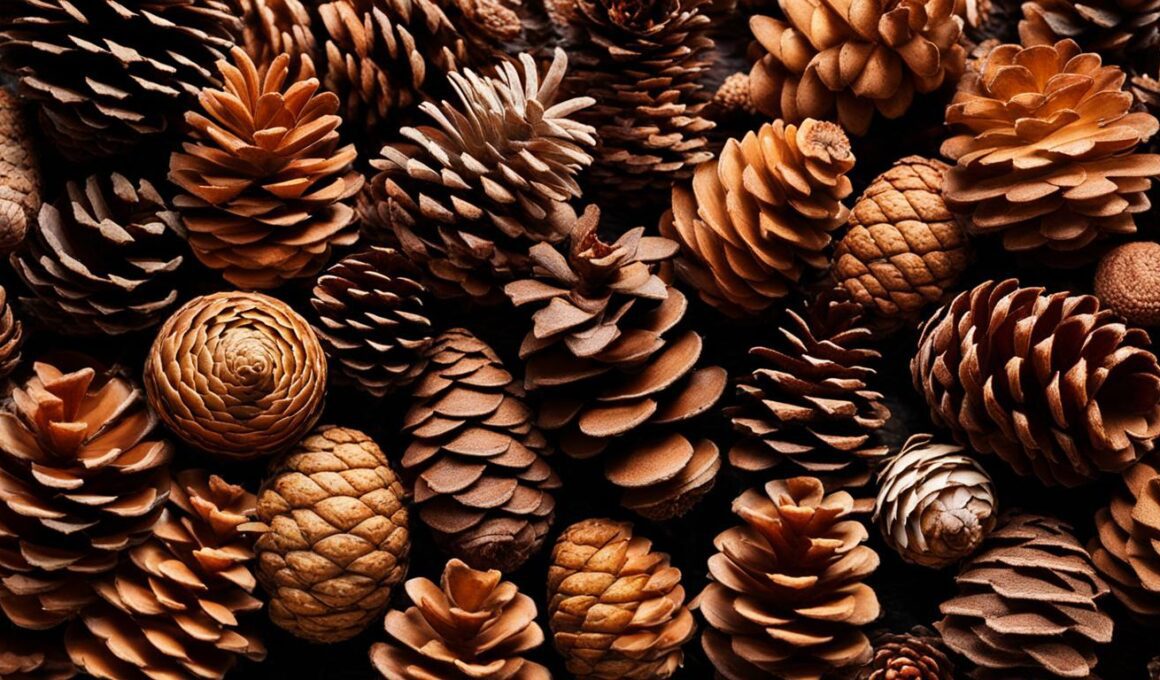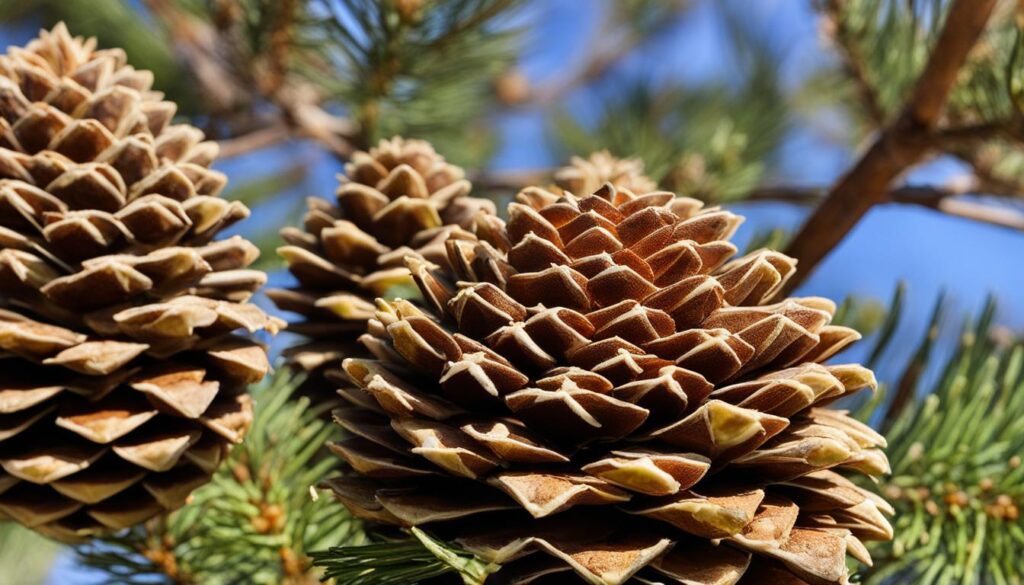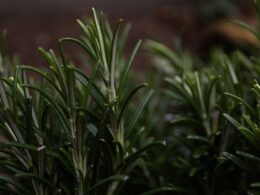Welcome to our article on the different varieties of pine cones! From the majestic Coulter Pine to the single-cone Eastern White Pine, there is a wide range of pine cone characteristics to explore. Whether you’re a nature enthusiast or simply curious about the fascinating world of conifer reproduction, you’ve come to the right place.
Pine cones are not just ordinary cones. They serve a crucial role in the reproductive cycle of conifers, safeguarding and dispersing their seeds. While some pine cones may be large and heavy, others are smaller and delicate. Each type has its own distinct characteristics that make it unique.
Throughout this article, we will delve into the different pine cone varieties, their characteristics, and their significance in the world of coniferous trees. So, get ready to discover the diverse world of pine cones!
Pine Cones vs. Seed Cones: Understanding the Differences
When it comes to the reproductive structures of conifers, there are two types of cones: pine cones and seed cones. These cones play a crucial role in the life cycle of coniferous trees, ensuring their survival and propagation.
Pine Cones: Pine cones are the female reproductive structures of coniferous trees. Their primary purpose is to produce ovules, which are fertilized by pollen from the male cones. This fertilization process leads to the formation of seeds, enabling the tree to reproduce and create new generations.
Pine cones not only serve as the site for fertilization but also protect the developing seeds from environmental conditions and predators. The cone scales tightly enclose the developing seeds, providing a safe and secure environment until they are ready for dispersal.
The shape and size of pine cones can vary among different species of conifers. Some pine cones, like those of the Coulter Pine (Pinus coulteri), are known for their large size and fascinating talon-like scales. These cones can weigh up to 11 pounds and are colloquially referred to as “widow-makers.”
On the other hand, seed cones are primarily associated with the male reproductive structures of conifers and are responsible for producing pollen. While both types of cones contribute to the reproduction of conifers, it is the pine cones that play a crucial role in seed development and protection.
Understanding the differences between pine cones and seed cones allows us to appreciate the intricate and fascinating reproductive mechanisms of conifers. These remarkable structures ensure the continuation of conifer species and contribute to the beauty and diversity of our natural landscapes.
Different Types of Pine Cones
Pine cones come in a variety of shapes, sizes, and colors. Understanding the different types of pine cones can give us insight into the diverse world of coniferous trees. Let’s explore some of the common types:
- Single-cone Pine Cones: These are the most common type of pine cones, known for their symmetrical shape. They typically have a cylindrical or oval appearance and consist of overlapping scales that protect the seeds within. Some examples of single-cone pine cones include:
- Eastern White Pine (Pinus strobus): This native North American pine tree produces large, slender, and elongated pine cones. The cones have thin, flexible scales and can measure up to 8 inches in length.
- Austrian Pine (Pinus nigra): Originating from Europe, this pine species features long, narrow pine cones with sharp scales. They are often used in landscaping due to their attractive appearance.
- Loblolly Pine (Pinus taeda): A common species found in the southeastern United States, loblolly pine trees produce serotinous cones that remain closed until exposed to fire. This adaptation helps them thrive in fire-prone environments.
- Jack Pine (Pinus banksiana): Native to North America, jack pines also have serotinous cones that rely on fire for seed release. The cones remain on the tree for several years until a fire clears space and triggers their opening.
- Red Pine (Pinus resinosa): As the name suggests, the cones of the red pine have a reddish-brown coloration, adding vibrancy to the forest floor.
- Sugar Pine (Pinus lambertiana): Known for its massive size, the sugar pine produces long and slender pine cones with a light brown color. These cones can reach up to 20 inches in length and are the largest of all pine cones.
- Longleaf Pine (Pinus palustris): Native to the southeastern United States, the longleaf pine cones are characterized by their dark brown color and elongated shape. They play a crucial role in the ecosystem by providing habitat and food for endangered species like the red-cockaded woodpecker.
- White Pine (Pinus strobus): In contrast to the other species mentioned, the cones of the white pine have a light brown or cream color, adding a touch of elegance to the landscape.
From the single-cone pine cones to the serotinous and colorful ones, each type has its own significance in the world of conifers. These fascinating structures not only contribute to the reproduction and survival of pine trees but also serve as a beautiful natural ornament.
Conclusion
In conclusion, pine cones come in a variety of types, each with its own unique characteristics. The diverse world of pine cones includes the massive and long cones of the sugar pine, known for their impressive size and beauty. On the other hand, lodgepole pines have serotinous cones, which are sealed with resin until fire opens them, ensuring the survival and regeneration of the species.
These pine cones play a crucial role in the reproductive cycle of conifers. They protect the seeds from the elements and predators, ensuring the next generation’s survival. Additionally, pine cones serve as nature’s seed dispersal mechanism, allowing the seeds to be carried away by wind, water, or animals to new areas for colonization.
By understanding the different types of pine cones and their distinct features, we gain a deeper appreciation for the intricate world of conifer reproduction. It is a testament to nature’s genius and the remarkable adaptations that allow these trees to thrive and propagate. So next time you come across a pine cone, take a moment to admire its beauty and the important role it plays in the circle of life.
Are Crab Apples and Pine Cones Similar in Terms of Varieties and Types?
Crab apples and pine cones are not similar in terms of varieties and types. While pine cones come in various sizes and shapes, types of crab apples vary based on their size, color, and flavor. The different types of crab apples make them a versatile choice for cooking and landscaping.
What Types of Pine Cones Can I Find in Texas?
When exploring pine trees Texas, you can find various types of pine cones such as loblolly pine, shortleaf pine, longleaf pine, and slash pine. Each type of pine cone has a unique shape and size, adding diversity to the beautiful landscapes of Texas.









